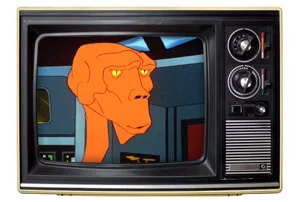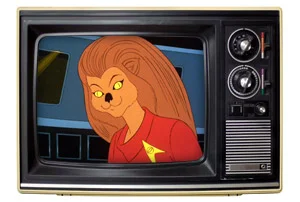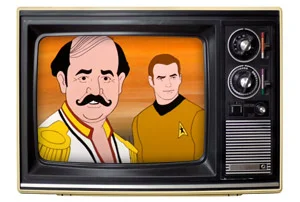An audio version of this Captain’s Log is available.
by Christopher Jones
Enterprise is often referred to as the fifth Star Trek series. In reality this is not true. There was a series between TOS and TNG that often gets overlooked. One that was created with ink and paper rather than cameras and lights. One that broke new ground for the franchise and kept Star Trek alive before the big screen voyages began. This was, of course, The Animated Series.
Produced by the animation house Filmation, Star Trek: The Animated Series aired on NBC from September 1973 to October 1974. It was a weekend ritual for children of those days, though unfortunately a short one. Saturday mornings at 10:30 a.m. (Eastern Time) the Enterprise would once again zip across the stars on adventures to where no flat-colored drawing had gone before.
Although technically the series ran for two seasons there were only 22 episodes ever produced, with the second season being limited to only six shows. Reruns continued into 1975 but there were no new episodes.
For many years The Animated Series was like the lost stepchild of Star Trek. Yet over the past decade this series has been brought into the fold by CBS, who now owns the Star Trek television franchise, and it has also been embraced by fans more so than ever before. Still many fans are either completely unaware of this series or know it merely by name and images seen on Star Trek websites and in magazines. And while it often contradicts established canon, it does have a place within the Star Trek family.
Meeting of the Minds
Like The Original Series, TAS draws its storytelling power from an all-star group of SF writers. These include Larry Niven, Samuel A. Peeples, D. C. Fontana, and David Gerrold. This SF experience lends both a connection to TOS and the same depth to the stories that has helped TOS stand the test of time.
There is another similarity between The Animated Series and The Original Series—an unfortunate one—that comes in the form of production value. While Filmation is often referred to as an experienced animation studio, the reality is that this studio founded by Lou Scheimer and Norm Prescott was known for producing low-budget cartoons during the 1970s and 80s. This perhaps made them a good choice for getting an animated Star Trek series to screen, but it also meant that the quality of production was—like TOS—on the low side.
Of course cartoons of the day were not as slick as those we are now accustomed to from studios like Pixar, but even by 1970s standards the illustration and inking of TAS was subpar. Like TOS however, the strength of the story often allows the viewer to overlook this.
We Are Family
With a team of talented writers in place the next piece of the puzzle was the cast. Specifically the voice cast. Bringing back all of the original characters would certainly be no problem since each animated character demanded far less money than their real-life counterpart. But to really pull off Star Trek the voices would have to be authentic. A Kirk that spoke like Elmer Fudd and a Spock that sounded like Marvin the Martian just wouldn’t cut it. So saving money on animation was really a must if NBC and Filmation were going to pull this off.
The studio was able to bring together almost all of the original actors from TOS. The noted exception was the character who was last to the party first go-around as well—Ensign Chekov. Walter Koenig’s Russian navigator was dropped from the series to save money, but the rest of the crew—including Majel Barrett—were on board. (And although Koeing was not part of the TAS voice cast, he did contribute to the series as a writer, penning the script for “The Infinite Vulcan.”)
Securing the original cast positioned TAS for success. It also meant that Filmation’s attempts to cut costs on animation were very justified because, despite the low visual quality of TAS, it was in fact the most expensive cartoon on television at the time.
In addition to voicing their own characters, several of the actors pulled double and even triple duty by voicing additional characters and the aliens that appeared in each episode. The most versatile was James Doohan, who, in addition to Mr. Scott, provided the voices for additional characters in every episode of the series.
New Faces
The 1701 family also gained a few new members in The Animated Series. Most notably are Arex, an Edosian navigator who took Chekov’s place on the bridge and was said to be Chekov’s navigation instructor at Starfleet Academy.
Voiced by James Doohan, Arex represented an ability that an animated series gave the writers and producers that a live-action series of that time could not—a truly alien presence on the bridge. Arex was the kind of alien that we’ve grown accustomed to seeing on series like TNG, DS9, and Voyager, requiring extensive prosthetics or CGI that would have burned through the budget in the 1970s.
Arex’s career did not end when The Animated Series left the air. Peter David has resurrected the character In His Star Trek: New Frontier series where he serves under Captain Shelby aboard the USS Trident.
Another addition to the bridge crew was M’Ress, a female Caitian who was the relief communications officer, filling in for Uhura when she was off-duty or otherwise unavailable. A humanoid feline, M’Ress represented—like Arex—an opportunity for a truly alien character to appear as a regular crew member at a time when production techniques made this difficult or impossible on a weekly live-action series. The voice of M’Ress was provided by Majel Barrett.
Old Faces
While Arex and M’Ress brought some new flavor to the show, some old faces also turned up to keep our animated crew on its toes. As with the crew itself, Filmation was able to bring in the original actors to voice several favorite TOS guest and recurring characters. These included Mark Lenard as Sarek (“Yesteryear”), Stanley Adams as Cyrano Jones (“Mudd’s Passion”), and Roger C. Carmel as Harry Mudd (“More Tribbles, More Troubles”). Sarek’s wife, Amanda Grayson, also appeared in “Yesteryear,” although she was voiced not by Jane Wyatt but instead by Majel Barrett.
Like Majel, James Doohan also provided the voices for some other familiar faces from TOS, including Commodore Robert Wesley (“One of Our Planets Is Missing”), and the Klingon trio of Kor, Koloth, and Kolox. Kor makes an appearance in “The Time Trap” while Koloth and Kolox team up in “More Tribbles, More Troubles,” with Doohan providing the voice of Koloth and writer David Gerrold voicing Kolox.
Not to be left out, the ever-popular Lieutenant Kyle appears in six episodes of The Animated Series: “Beyond the Farthest Star”; “One of Our Planets Is Missing”; “The Survivor”; “Mudd’s Passion”; “The Terratin Incident”; and “Bem.” (Doohan provides the voice, though he only has a speaking role in “Farthest Star.” Poor animated Kyle.)
And the Emmy Goes to…
An interesting twist of the Forgotten Series Syndrome from which TAS has suffered for nearly four decades is the fact that it accomplished something that its predecessor did not. TAS won an Emmy Award.
The Original Series had often been nominated for an Emmy during its 1966-1969 run, but failed to bring home the honor. TOS received 13 nominations yet amazingly went 0-13. It wasn’t until 1975 that the franchise grabbed the first of its eventual 33 Emmy Awards, and it was The Animated Series that broke the ice by winning the Daytime Emmy for Outstanding Entertainment Children’s Series.
Once TAS broke new ground for Star Trek in the Emmys, every series would go on to bring in Emmy Awards for the franchise. The next win would come in 1988 with The Next Generation episode “11001001,” which won for Outstanding Sound Editing for a Series. In all Star Trek would go on to garner a total of 155 nominations through the end of Enterprise in 2005 and winning a total of 33 little statuettes.
Coming of Age
Despite this success, The Animated Series was largely forgotten as Star Trek began to flourish, first on the big screen and then once again on television. Star Trek: The Motion Picture ushered in a new age of live-action Trek, followed by three more feature films spread across the 80s and then a return to the small screen in 1987 with The Next Generation. We all know what happened next. And in all this excitement, the animated members of our family fell into the shadows.
Not to go completely into retirement, the TAS crew appeared in the 1990s on the Sci Fi Channel. From 1992 until 1995 the network broadcast a collection of cartoons under a block titled “Cartoon Quest.” Star Trek: The Animated Series was amongst these shows. In 1995 the name of the block was changed to “The Animation Station” and Star Wars came into favor with the Droids and Ewoks series. But this burst of exposure provided TAS with a bit of life in the decade of the 90s, just as it had gotten in the 80s when Nickelodeon had shown reruns of the series.
These bursts of life in each decade after first-run helped propel TAS into the naughts, where it was finally given its rightful place within the Star Trek family by CBS. The coming of age story for the crew of the animated Enterprise ends in 2006 with the release of the Star Trek: The Animated Series DVD box set. The collection includes not only all 22 episodes but also special features and interviews, giving TAS the same treatment that its live-action siblings received. You can be sure a lot of Romulan Ale was consumed on the Enterprise that night.
Since then an effort has been made by CBS and fan sites such as Memory Alpha to incorporate TAS into the greater Star Trek canon. It can be tough at times because there are elements of the series that just don’t mesh with TOS. But to be fair, there’s a lot in TOS that doesn’t mesh with itself. The more Trek we have, the richer the story becomes; and The Animated Series provides us with 22 more great adventures for the crew of the 1701.









